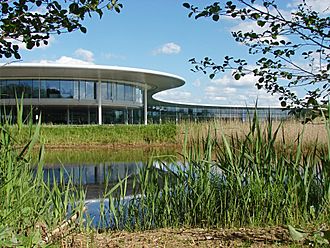McLaren Technology Centre facts for kids
Quick facts for kids McLaren Technology Centre |
|
|---|---|
 |
|
| General information | |
| Architectural style | Modern |
| Location | Woking, England |
| Current tenants | McLaren Group |
| Construction started | 1998 (McLaren Technology Centre) 2010 (McLaren Production Centre) |
| Completed | 2003 (McLaren Technology Centre) 2011 (McLaren Production Centre) |
| Inaugurated | 12 May 2004 |
| Cost | £300 million (est.) |
| Owner | McLaren Group |
| Technical details | |
| Floor count | 1 to 5 |
| Design and construction | |
| Architect | Norman Foster |
| Awards and prizes | 2005 Stirling Prize (Shortlisted) |
The McLaren Technology Centre is the main office for the McLaren Group. It is located in Woking, Surrey, England. This huge complex has two main buildings. The first is the original McLaren Technology Centre. It serves as the main headquarters. The second is the newer McLaren Production Centre. This building is mostly used to build McLaren Automotive cars.
The main building is shaped like a large half-circle. It has glass walls and was designed by the famous architect Norman Foster. The building was considered for a big award in 2005, the Stirling Prize. About 1,000 people work here. It is home to the McLaren Formula One racing team. It also houses McLaren Automotive, which makes supercars like the McLaren F1 and McLaren Senna.
In 2011, the centre became twice as big. This happened when the McLaren Production Centre was built. McLaren also plans to add another part to this building. It will be used for advanced technology and a new wind tunnel for racing.
Contents
Cool Features of the Centre
The McLaren Technology Centre has several special features.
Lakes and Cooling System
Around the building, there are several artificial lakes. One big lake is right in front of the building. Four other lakes are designed to look natural. All these lakes hold about 50,000 cubic metres of water. This water is used to cool the building. It also helps remove heat from the powerful wind tunnels.
Inside the Building
The main work areas are divided into 18-metre wide sections. These are called 'fingers'. They are separated by 6-metre wide hallways, known as 'streets'. Employees have great facilities. These include a large 700-seat restaurant. There is also a juice and coffee bar, a swimming pool, and a fitness centre. A special Visitor and Learning Centre is underground. It connects to the main building by a walkway.
The Wind Tunnel
One end of the building has a 145-metre long wind tunnel. It is shaped like a rectangle. The McLaren racing team uses it to test car parts. They check how air flows over the cars. This helps them make the cars faster. The tunnel uses 400 tonnes of steel. A large 4-metre wide fan pushes the air. This fan can spin up to 600 rpm.
The Technology Centre brought all parts of the McLaren Group together. Before, they were spread across 18 different places.
History of the McLaren Centre
The idea for a new McLaren headquarters started in 1995. The local council approved it. However, building such a large site on 'green belt' land was unusual. This led to a public review. In 1997, the Environment Secretary, John Gummer, gave his approval. He said McLaren was "exceptional" and deserved special permission.
Building the Centre
Construction began in 1998. The project was first called the 'Paragon Technology Centre'. About 4,000 construction workers helped build it. The Financial Times newspaper called it a very big private construction project in Europe. In 2000, DaimlerChrysler bought a part of the McLaren Group. McLaren then announced they would build the Mercedes-Benz SLR McLaren at the new facility.
McLaren employees started working in the new building in May 2003. The exact cost was not shared. However, BBC News suggested it cost around £300 million.
McLaren Production Centre
A second building, the McLaren Production Centre, was built next to the Technology Centre in 2011. This is where McLaren Automotive makes its road cars. These include models like the McLaren 720S and McLaren Senna.
Future Expansion
In 2016, plans for an extension were approved. This new part will be an "applied technology centre." It will have areas for aerodynamic research and workshops. There will also be offices, meeting rooms, and training spaces.
See also
 In Spanish: Centro de Tecnología McLaren para niños
In Spanish: Centro de Tecnología McLaren para niños


